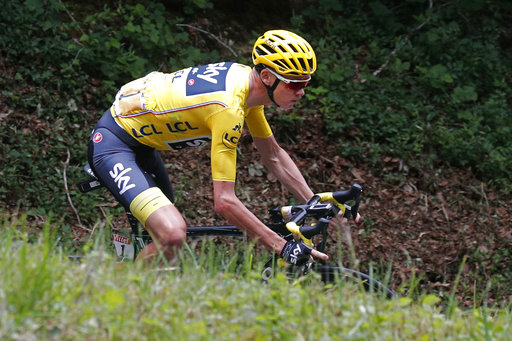
Britain’s Chris Froome, wearing the overall leader’s yellow jersey, speeds downhill during the ninth stage of the Tour de France cycling race over 181.5 kilometers (112.8 miles) with start in Nantua and finish in Chambery, France, Sunday, July 9, 2017. (AP Photo/Christophe Ena)
CHAMBERY, France — Chris Froome probably hoped he had a bigger lead than his 18-second advantage over Fabio Aru on the Tour de France’s first rest day.
At least he’s still in one piece, though.
Richie Porte, Froome’s most feared opponent, and Geraint Thomas, Froome’s most loyal support rider at Team Sky, both crashed out of the race on Sunday.
With Colombian climbing specialist Nairo Quintana and seven-time Grand Tour winner Alberto Contador dropping out of contention, it seems there’s only a handful of riders remaining who can still challenge Froome for the title in Paris on July 23.
Aru, the Italian champion and 2015 Spanish Vuelta winner, leads the list followed closely by last year’s runner-up Romain Bardet, the Frenchman who is third overall, 51 seconds back.
Rigoberto Uran, the Colombian who was a two-time runner-up in the Giro d’Italia, is fourth at 55 seconds and Aru’s Astana teammate, Jakob Fuglsang of Denmark, is fifth at 1:37.
The only other rider within two minutes of Froome is Dan Martin, the Irish cyclist who excels on the shorter, steeper climbs that are so prevalent in this year’s race.
“I said (Saturday) that I expected the general classification to be blown up and looking at it, it has,” Froome said. “It’s a lot more spread out now.”
Froome and the other 181 riders still in the three-week race flew across the country late Sunday to southwestern France, where after Monday’s rest day the race resumes with two flat stages suited for sprinters.
The overall battle probably won’t see any changes until the race enters the Pyrenees Thursday and Friday with 16-percent slopes to the Peyragudes ski station and 18-percent stretches on the Mur de Peguere.
After some milder climbing in the Massif Central the Tour returns to the Alps for the so-called “Queen stage” — an unprecedented mountain-top finish at the Col d’Izoard.
The hostile terrain of sun- and snow-scorched rocks and the thinning mountain air on the long climb to an altitude of 2,360 meters (7,742 feet) could make the Izoard, at the end of stage 18, the scene of the last major contest between the remaining favorites.
Aiming to secure his fourth title in five years, Froome likely needs only the slimmest of margins — or even a small deficit — entering the 22.5-kilometer (14-mile) time trial in the Mediterranean port city of Marseille on the penultimate stage 20.
A superb time trialer, Froome should be able to take time on all of his rivals in the race against the clock — just like he did in Stage 1.
Whoever wears yellow at the end of the day in Marseille will cruise around the Champs-Elysees in the mostly ceremonial final leg a day later and pick up the trophy.
Right now, though, it’s all about recovery for Froome and the other leaders after Sunday’s punishing mountain leg.
Rest days, however, are not just for resting.
Almost every rider will go out and train for an hour or two Monday just to keep their bodies from shutting down.
Cannondale-Drapac team manager Jonathan Vaughters explained that the approach to rest days isn’t really understood scientifically because there have not been enough studies of elite riders performing three-week races.
“So what you’re doing is based on theory and anecdote. The pure science would say, ‘Stay in bed all day and don’t move.’ But that doesn’t work,” Vaughters said. “It’s the same as turning the engine off. You just can’t get it started again.
“It’s like studying hard for exams. You’re fine, fine, fine. Then you take the exam and get home from the exam and then the next day you have the flu,” Vaughters said. “You’re like, ‘Now I can rest.’ And then boom, you’re sick.”